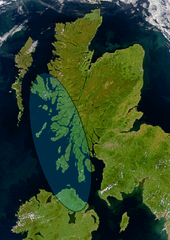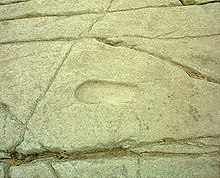Áedán mac Gabráin

Áedán mac Gabráin (Old Irish pronunciation:
He was a contemporary of
The
Sources
The sources for Áedán's life include Bede's
The
Áedán additionally appears in a variety of Welsh sources, making him one of the few non-
Neighbours
Áedán was the chief king in Dál Riata, ruling over lesser tribal kings. The Senchus fer n-Alban records the sub-divisions of Dál Riata in the 7th and 8th centuries, but no record from Áedán's time survives. According to the Senchus, Dál Riata was divided into three sub-kingdoms in the 7th century, each ruled by a kin group named for their eponymous founder. These were the Cenél nGabráin, named for Áedán's father, who ruled over Kintyre, Cowal and Bute; the Cenél Loairn of northern Argyll; and the Cenél nÓengusa of Islay. Within these there were smaller divisions or tribes which are named by the Senchus.[13] Details of the Irish part of the kingdom are less clear.
Looking outward, Dál Riata's neighbours in north Britain were the
In Ireland, Dál Riata formed part of
Reign

Adomnán, the Senchus fer n-Alban and the Irish annals record Áedán as a son of Gabrán mac Domangairt (died c. 555–560). Áedán's brother Eoganán is known from Adomnán and his death is recorded c. 597.[17] The Senchus names three other sons of Gabrán, namely Cuildach, Domnall, and Domangart.[18] Although nothing is known of Cuildach and Domangart or their descendants, Adomnán mentions a certain Ioan, son of Conall, son of Domnall, "who belonged to the royal lineage of the Cenél nGabráin",[19] but this is generally read as meaning that Ioan was a kinsman of the Cenél nGabráin, and his grandfather named Domnall is not thought to be the same person as Áedán's brother Domnall.[20]
Áedán was about forty years old when he became king, following the death of his uncle Conall mac Comgaill in 574.[21] His succession as king may have been contested; Adomnán states that Columba had favoured the candidacy of Áedán's brother Eoganán.[22] Adomnán claims that Áedán was ordained as king by Columba, the first example of an ordination known in Britain and Ireland.[23]
In 574, following the account of Conall's death, the Annals of Ulster and the Annals of Tigernach record a battle in Kintyre, called the Battle of Teloch, or Delgu. The precise location of the battle is unidentified. The annals agree that "Dúnchad, son of Conall, son of Comgall, and many others of the allies of the sons of Gabrán, fell."[24] In 575, the Annals of Ulster report "the great convention of Druim Cett", at Mullagh or Daisy Hill near Limavady, with Áed mac Ainmuirech and Columba in attendance.[25] Adomnán reports that Áedán was present at the meeting.[26] The purpose of the meeting is not entirely certain, but one agreement made there concerned the status of Áedán's kingdom. Áedán and Áed agreed that while the fleet of Dál Riata would serve the Uí Néill, no tribute would be paid to them, and warriors would only be provided from the Dál Riata lands in Ireland.[27]
The reason for this agreement is thought to have been the threat posed to Áedán, and also to Áed, by Báetán mac Cairill. Báetán is said to have forced the king of Dál Riata to pay homage to him at Rosnaree on
Áedán's campaigns on the Isle of Man have sometimes been confused with the battle against the Miathi mentioned by Adomnán. The Miathi appear to have been the Maeatae, a tribe in the area of the upper river Forth. This campaign was successful, but Áedán's sons Artúr and Eochaid Find were killed in battle according to Adomnán.[31] This battle may have taken place c. 590 and been recorded as the Battle of Leithreid or Leithrig.[32]
The
A number of Welsh traditions point to warfare between Áedán and King
Degsastan and after
Degsastan appears not to have been the first battle between Áedán and the Bernicians. The death of his son Domangart in the land of the Saxons is mentioned by Adomnán, and it is presumed that Bran died in the same otherwise unrecorded battle.[37]
Of the roots of this conflict, Bede mentions only that Áedán was alarmed by Æthelfrith's advance. Wherever the Battle of Degsastan was fought, Bede saw it as lying within
After the defeat of Degsastan, the annals report nothing of Áedán until his death around six years later, perhaps on 17 April 609, the date supplied by the
Áedán's descendants
Áedán was succeeded by his son, Eochaid Buide. Adomnán gives an account of Columba's prophecy that Eochaid's older brothers (listed as Artúr, Eochaid Find and Domangart) would predecease their father.[41] Áedán's other sons are named by the Senchus fer n-Alban as Eochaid Find, Tuathal, Bran, Baithéne, Conaing, and Gartnait.[42] Adomnán also names Artúr, called a son of Conaing in the Senchus, and Domangart, who is not included in the Senchus. Domangart too may have been a grandson rather than a son of Áedán, most likely another son of Conaing. The main line of Cenél nGabráin kings were the descendants of Eochaid Buide through his son Domnall Brecc, but the descendants of Conaing successfully contested for the throne throughout the 7th century and into the 8th.[43]
It has been suggested that Gartnait son of Áedán could be the same person as
Less is known of Áedán's daughters. Maithgemm, also recorded as Gemma, married a prince named Cairell of the Dál Fiatach. The names of Áedán's wives are not recorded, but one was said to be Brittonic, and another may have been a Pictish woman named Domelch, if indeed the Gartnait son of Domelch and Gartnait son of Áedán are one and the same.[45]
Notes
- ^ Hughes; Bannerman; Fraser.
- ^ Bannerman, pp. 89–90
- ^ Byrne, "Ireland and her neighbours", p. 897. Fraser, p. 296, notes that "the 'discovery' of a genealogical link" was a common result of an alliance.
- ^ MacQuarrie, p. 109. The Echtra Áedáin mac Gabráin is listed in "Scéla: Catalogue of medieval Irish narratives & literary enumerations". Archived from the original on 31 December 2006. Retrieved 26 December 2006.
- romance".
- ^ Wiley, Dan M. (2004) "The Cycles of the Kings: Compert Mongáin" Archived 6 October 2008 at the Wayback Machine Hastings College. Retrieved 16 September 2009.
- ^ a b Bromwich, p. 272.
- ^ a b Bromwich, p. 272, 494.
- ^ Bromwich, pp. 62-65; Jones, p. 39. Though this triad, like the Bonedd Gwŷr y Gogledd, flips father and son's names as Gauran map Aedan, Bromwich p. 64 takes it as a reference to Áedán rather than his father.
- ^ Bromwich, p. 64, 273.
- ^ Bromwich, pp. 256–257
- ^ Bromwich, pp. 272–273.
- ^ Bannerman, pp 47–49 and 108–118; Charles-Edwards, pp. 296–297.
- ^ An overview of the politics of northern Britain can be found in, for example, Yorke, pp. 33–97.
- ^ See, for example, Byrne, Irish kings, pp. 106ff.; Charles-Edwards, pp. 54–67, 293–299, & pp. 481ff.
- ^ Revealed: carved footprint marking Scotland's birth is a replica, The Herald, 22 September 2007.
- ^ Adomnán, III, 5; Anderson, ESSH, p. 118; Bannerman, p. 90.
- ^ Anderson, ESSH, p. cl; Bannerman, p. 48.
- ^ Adomnán, II, 22.
- ^ Adomnán, II, 22, translator's note 258; Bannerman, p. 107.
- ^ Bannerman, p. 81.
- ^ Adomnán, III, 5.
- ^ Adomnán, III, 5 and translator's note 358; Broun; Byrne, Irish kings, p. 159; Yorke, p. 241.
- ^ Bannerman, pp. 81–82; Anderson, ESSH, pp. 78–79; M.O. Anderson, p. 149, suggests that Báetán mac Cairill may have been the enemy against whom the battle was fought.
- ^ Anderson, ESSH, p. 79. The date of Druim Cett has been disputed. Sharpe, in the editor's notes to Adomnán's Life, note 204, proposes a much later date, c. 590. Sharpe is followed by Meckler ("The Annals of Ulster and the date of the meeting at Druim Cett", Peritia, vol. 11, 1997) but this is challenged by Jaski ("Druim Cett revisited", Peritia, vol. 12, 1998). Charles-Edwards, Early Christian Ireland, p. 491, takes the meeting to have been "some years later" than 575.
- ^ Adomnán, I, 48.
- ^ Anderson, ESSH, p. 83, note 2; M.O. Anderson, pp. 148–149; Bannerman, pp. 1–2; Byrne, Irish kings, p. 110.
- ^ Anderson, ESSH, pp.87–88; Bannerman, pp. 2–4; Byrne, Irish kings, pp. 109–111; Ó Cróinín, Early Medieval Ireland, pp. 50–51.
- ^ Anderson, ESSH, p. 89; Bannerman, pp. 83–84; Ó Cróinín, pp. 50–51.
- ^ Adomnán, II, 42, and translator's note 324; Anderson, ESSH, p. 86; Bannerman, pp. 79 & 83.
- ^ Adomnán, I, 8–9 and translator's note 81; Bannerman, pp. 82–83. Bannerman, pp. 90–91, notes that Artúr is the son of Conaing, son of Áedán in the Senchus fer n-Alban.
- ^ Anderson, ESSH, p. 94; Bannerman, pp. 84–85 and 91.
- ^ Bannerman, pp. 84–86.
- ^ The Battle of Asreth is apparently misdated, appearing under 752 in the Annals of Tigernach; see M.O. Anderson, pp. 30–31 & 36–37.
- ^ Adomnán, I, 15 and translator's note 89; Bannerman, pp. 88–89.
- ^ MacQuarrie, p. 109.
- ^ Adomnán, I, 9; Bannerman, pp. 85 and 91–92.
- ^ Bede, I, 34; Bannerman, pp.86–88; Byrne, Irish kings, p. 111; Kirby, pp. 70–72. MacQuarrie, pp. 103–104, notes some textual inconsistencies in the Irish sources, and suggests that the "Battle of the Saxons" recorded in the Irish annals may not be Bede's "Battle of Degsastan".
- ^ Bannerman, pp.80–81; Fraser, Caledonia to Pictland, p. 141.
- ^ Bannerman, pp. 80–81 and 86–87.
- ^ Adomnán, I, 9.
- Old Englishcyning, king; Byrne, Irish kings, pp.111–112. The appearance of two sons named Eochaid is not an error, as noted by Charles-Edwards, p. 6.
- ^ Adomnán, I, 9; Anderson, ESSH, pp.95–96; Bannerman, pp. 47–49, 90–96 and 103.
- ^ Anderson, ESSH, pp. 121–123 and 145; Bannerman, pp. 93–94, Smyth, p.70. On Pictish matriliny in general, see Woolf. That the Pictish king Nechtan and Nechtan son of Cano are the same person is questionable: see M.O. Anderson, pp. 116 & 154; MacQuarrie, pp. 167–170.
- ^ Bannerman, pp. 88–89. A daughter named Conchenn is mentioned in the medieval glosses on the Amra Columcille.
References
- ISBN 0-14-044462-9
- ISBN 1-871615-03-8
- ISBN 0-7011-1604-8
- ISBN 0-7011-2040-1
- ISBN 0-14-044565-X
- ISBN 0-7083-1386-8
- ISBN 0-19-211696-7
- ISBN 0-19-922665-2
- Byrne, Francis John (1973), Irish Kings and High-Kings, London: Batsford, ISBN 0-7134-5882-8
- Charles-Edwards, T. M. (2000), Early Christian Ireland, Cambridge: Cambridge University Press, ISBN 0-521-36395-0
- ISBN 978-0-7486-1232-1
- Jones, Bedwyr L. (1990), "Gwriad's Heritage: Links Between Wales and the Isle of Man in the Early Middle Ages", Transactions of the Honourable Society of Cymmrodorion: 29–44, ISSN 0959-3632
- Ó Cróinín, Dáibhí (1995), Early Medieval Ireland: 400–1200, London: Longman, ISBN 0-582-01565-0
- ISBN 0-19-922665-2
- Kirby, D. P. (1991), The Earliest English Kings, London: Unwin, ISBN 0-04-445692-1
- MacQuarrie, Alan (1997), The Saints of Scotland: Essays in Scottish Church History AD 450–1093, Edinburgh: John Donald, ISBN 0-85976-446-X
- Smyth, Alfred P. (1984), Warlords and Holy Men: Scotland AD 80–1000, Edinburgh: Edinburgh UP, ISBN 0-7486-0100-7
- ISSN 0020-157X
- ISBN 0-582-77292-3
External links
- CELT: Corpus of Electronic Texts at University College Cork includes: the Gein Branduib maic Echach ocus Aedáin maic Gabráin, the Scéla Cano meic Gartnáin, and Irish annals, some with translations
- Compert Mongán translated by Mary Jones.
- Artúr mac Aedan of Dalriada by Michelle Ziegler, The Heroic Age Issue 1, Spring/Summer 1999
- Scéla – a catalogue of medieval Irish narratives
